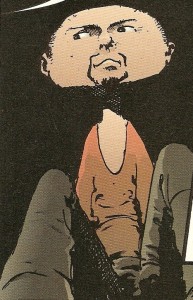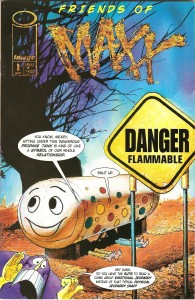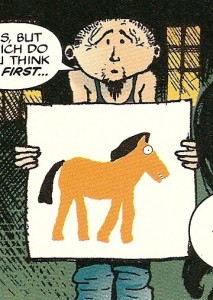
Dude Japan is a character that was created by Sam Kieth for a comic book called Friends of Maxx. It debuted in 1996 and was published by Image Comics. Originally intended to be an ongoing series, it was canceled after the third issue. All three issues are independent, character-driven stories that venture into the unforgiving world of the mundane. The first issue of Friends of Maxx is a 48 page story with heavy dialogue and no advertisements. The word balloons actually occupy more space than the artwork. The cover asks the question, “Do you have the guts to read a comic about emotional jeopardy, instead of that typical physical jeopardy crap?” Well, I took the challenge, and it forever changed my view of comics as a medium for story-telling. I could easily write volumes about the Friends of Maxx comics, but I’m here to talk about the first issue’s main character: Dude Japan.
That name has resonated with me since I first read Friends of Maxx #1 in 2002. I’m not sure why, but Dude became a permanent part of my subconscious. Maybe it’s because I was going through similar personal trials at the time, or maybe it’s because he’s such a relatable character. Dude’s not a superhero fighting crime by night, or an alien powered by Earth’s yellow sun. He’s just a struggling artist that works at a mall, goes home to a dirty house, and fights with his girlfriend. He’s full of anger, disappointment, and pain. There’s more weakness within him than there’s power.
Who is Dude Japan, and what makes him tick? Well, I’ve decided to dedicate this week’s Unsung Characters of Comicdom to answering that question with the following profile:
First Appearance: Frinds of Maxx #1
Build: Although he appears tall and thin, his height varies from panel to panel due to Sam Kieth’s liberal art style.

Age: Unknown (maybe late 20s/early 30s)
Race: Unknown (possibly Asian/Caucasian)
Marital Status: Single
Occupation: Salesman, Conceptual Artist
Dwelling: Just imagine a giant smurf cottage painted in sepia tones, and that’s Dude’s house. It’s his only valuable possession, and he uses it as leverage against his live-in girlfriend, Mickey.
Personality: Dude has a short temper and lives the majority of his life in seclusion. He internalizes most of his pain, and there’s a sadness deep within him that rarely escapes. His only true release is in his drawings, and he won’t share those with others because of his insecurities. Attempts to get him to open up are only met with unrelenting evasiveness and dishonesty.

Motivation: Dude Japan’s artwork is his driving force and salvation. No one understands what he’s doing artistically, not even his girlfriend. Art is his only passion, but he’s extremely apprehensive about showing his drawings to others, due to fears of rejection. On the occasion that he actually shows someone his artwork, he’s harshly ridiculed. Although negative criticism works to further alienate him, it also serves as an unhealthy motivation.
Artwork: He refers to his work as pop art. Not like Roy Lichtenstein or Andy Warhol, but he’ll accept the comparison. As Dude puts it, his art is the “reproduction of the crude simplifications from pages of children’s books, utilizing a special medium that conveys the ironic symbolism.” In short, he traces pictures from coloring books and renders them with crayons. When describing one of his pieces to his girlfriend, he calls it, “a sarcastic indictment of a mass market commercial icon.” In reality, it’s a crude drawing of Pokey from The Gumby Show. To which Mickey apathetically responds, “It’s orange.” That’s pretty much a summary of his relationship with her. He sees himself as an undiscovered artistic genius, and she thinks his work lacks the depth to be considered true art. Though she’s tolerant of his hobby, she doesn’t respect or understand it.
Relationships: Dude’s a one girl type of man. Although his relationship with Mickey is mainly an ‘on again/off again’ type of situation, he never considers being with anyone else. During their down time, he just broods over her and longs for their passionate reunion. It’s evident that he truly loves her, and his romantic feelings run very deep. Unfortunately, he lacks the motivation to properly express them. He wants his girlfriend to be a mother figure but gets angry when she assumes that role. Dude needs to be taken care of. Ironically, he hates sacrificing independence for the sake of being comfortable. This inner conflict is a driving force for his resentment towards Mickey. He also lies to her, which he considers a necessary evil to keep her happy. In actuality, his dishonesty is just a selfish way to maintain his own disillusions of happiness. The more he deceives her, the more guilt he feels. In short, their relationship is flawed and paradoxical.
Allies: Sid Kroftt is Dude’s only true friend. Sid found Dude’s artwork while perusing the mall with his grandmother. When Sid first sees Dude’s artwork, he says, “It’s as if Warhol, Oldenburg, and Rosenquist all mated and begat an entirely new art form.” To which Dude exclaims, “He gets it!” Sid introduces himself as an art dealer, but it’s later revealed that he’s nothing more than a waiter at a coffee shop. It turns out that Sid has been given a portion of the coffee shop’s wall to display artwork of his choosing, and the art that he decides to showcase are the drawings of Dude Japan. Later he’s given the whole wall, and eventually, an entire art show. Regardless of the show’s complete failure, Sid adamantly reaffirms Dude’s artistic talent. This unwavering dedication to Dude and his artwork becomes the foundation for a strong and lasting friendship. Dude’s girlfriend, Mickey, is less of an ally and more of an enabler. She eventually steps into a larger role in his life, but I’ll let you read the book to see what that role is and how it develops.
Antagonists: Everyone and everything is out to get Dude. Other than Sid, no supporting characters are on his side, and it appears that all outside forces are working against him. In addition, Dude’s behavior is self-defeating, creating an enemy from within. Just when you think it can’t get any worse, it does. His boss fires him for incompetence, and his girlfriend leaves him for numerous reasons. Adding insult to injury, Wayne T’pali (Dude’s biggest artistic influence) tells him that he’s “three levels below a hack.” After the failure of his coffee shop art show, he hits rock bottom. Dude is far from perfect, and these overwhelming circumstances give him the endearing role of an underdog. I won’t reveal whether there’s a happy ending or not, but I will say that this issue has a satisfying and emotional ending.
If you haven’t read Friends of Maxx #1, you’re missing out on a great piece of comic history. If you’re a fan of The Maxx, you may be disappointed that the only similarity to The Maxx series is the book’s title. There’s a cameo where Maxx briefly appears in issue #1, but this tale has nothing to do with the original Maxx series. Sam Kieth actually received criticism for using Maxx in the title in order to better market the book. I’m not sure if the Friends of Maxx title was Kieth’s decision or the publishers, because he never responded to the claim.
There were three installments in this series, but Dude has little involvement in the other two issues. This story stands alone and could have easily been a one-shot. If you see this one in the back issue bins, pick it up and check it out. It’s well worth it.
Josh Jones
Josh@comicattack.net

The MAXX animated series was nifty. Great column
There’s a manga/anime called Paradise Kiss, where the relationship between the two main characters is similar to the one you describe between Micky and Dude. The guy loves women who are independent and ambitious, the girl just wants to be with the guy. The more she falls in love with him, the more he resents her. The more independent she becomes, the more he loves her, but the less of a relationship they have.
….
Alright, maybe that’s not even remotely similar. But it reminded me of ParaKiss. Particularly because the main guy is a fashion designer.
I’ll just…go over there….
I enjoyed this very much. Some of the BEST stories about artists are focused on how they handle their personal relationships.
This sounds very interesting. I’d like to read it someday just because it’s so dialogue driven rather than action driven. A very unique concept.
Ok, I’m sold; if I find this issue anywhere, I’ll drop the back issue bin tag for it!
Lol. I just found an issue of this in my collection. Weird. I just read it. Very unique.
I will check out this comic now